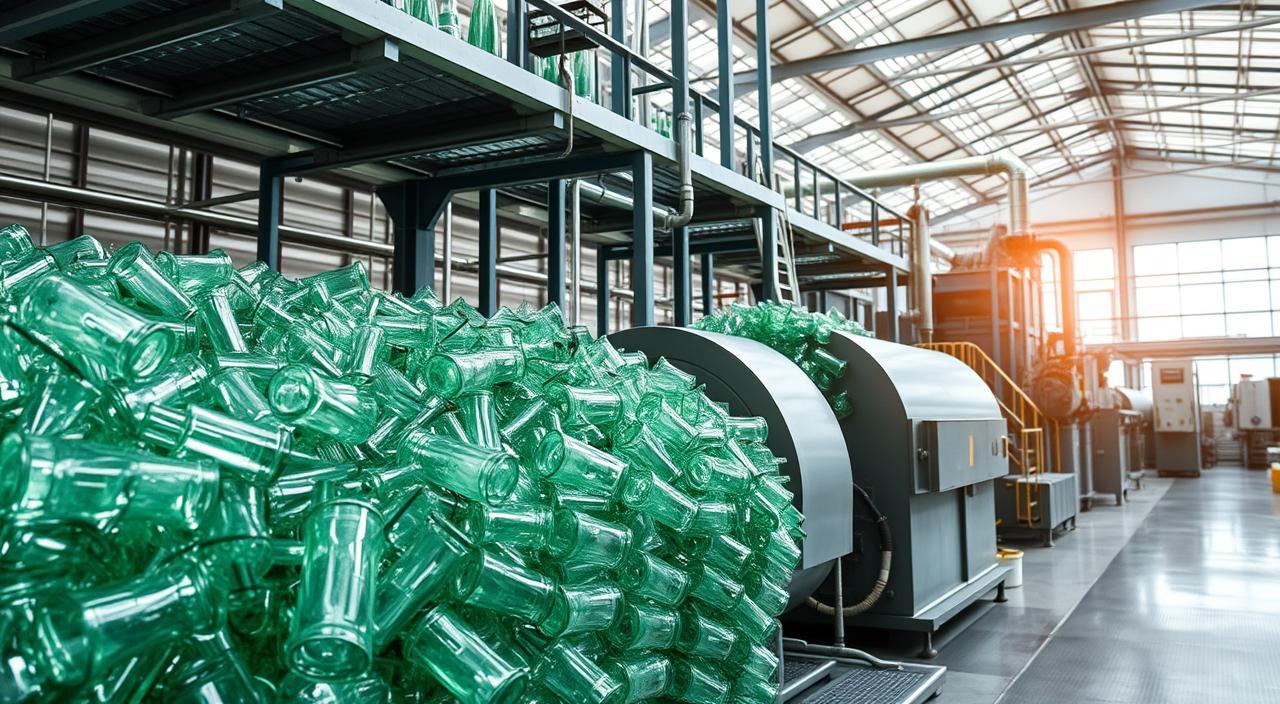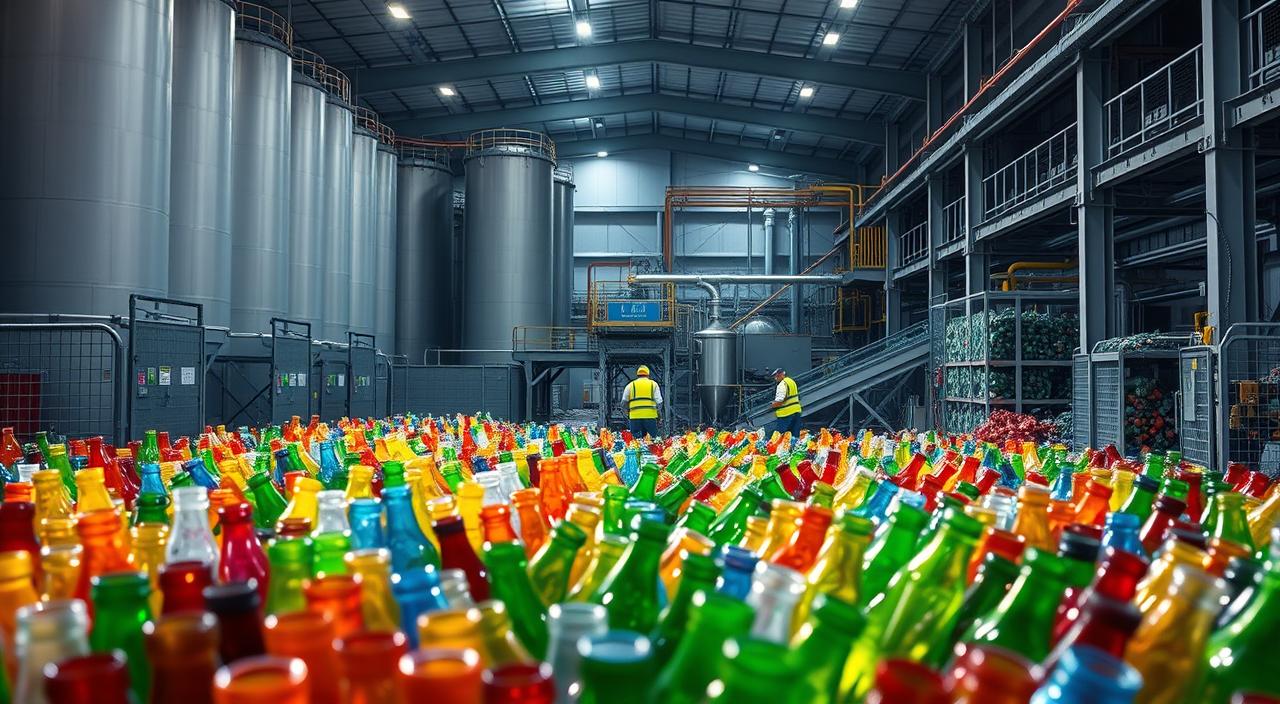Glass bottle recycling UK is a powerful example of how a small action—placing a clean jar in the right bin—can have big environmental impact. In Britain, over 70% of container glass is already being recycled. With targets aiming for 90% by 2030, your efforts matter more than ever.

This article uncovers the full journey your bottles take after collection. From curbside pickup to high-tech colour sorting, from molten glass to supermarket shelves, you’ll learn how a single action supports a massive circular system designed to conserve resources and reduce landfill.
Key Takeaways
- The UK currently recycles 71% of glass bottles and jars
- Targets aim for a 90% recycling rate by 2030
- Glass is 100% recyclable with no quality loss
- Recycling glass reduces carbon emissions and saves raw materials
- A bottle recycled today could be back on shelves in 30 days
Why Glass Bottle Recycling UK Is Essential
Each glass container you recycle helps protect natural ecosystems and preserve limited resources. When processed correctly, glass can be reused indefinitely—unlike many plastics that degrade in quality over time.
Environmental Benefits
- Reduces the need to mine raw materials like sand and limestone
- Cuts furnace energy use by 40%
- Prevents 1.8kg of household waste per month from entering landfills
- Reduces harmful emissions like nitrogen oxides and CO₂
What Resources Are Saved?
| Resource | Virgin Extraction (per tonne) | Saved Through Recycling |
|---|---|---|
| Sand | 1,300 lbs | 100% preserved |
| Soda Ash | 410 lbs | 94% saved |
| Limestone | 380 lbs | Entirely avoided |
| Feldspar | 160 lbs | No mining required |
How Glass Bottle Recycling UK Works: Step-by-Step

Modern recycling in the UK relies on advanced, efficient infrastructure to turn discarded bottles into brand-new products with minimal waste.
1. Collection and Sorting
Bottles are collected via kerbside bins and public bottle banks. After arrival at recycling centres:
- Labels are stripped using water jets
- Lids are removed with magnets
- Colour-sorting machines separate green, clear, and amber glass
- Optical scanners detect and remove contaminants
| Stage | Action | Result |
|---|---|---|
| Pre-treatment | Cleaning and de-labelling | Clean, pure glass loads |
| Colour Sort | Laser scanning | Sorted by hue |
| Manual Check | Staff remove outliers | Quality control ensured |
2. Crushing and Melting
- Sorted glass is crushed into granules (cullet)
- Cullet melts at 1,400–1,500°C
- Molten glass is poured into moulds to create new jars or bottles
3. Final Quality Checks
- Reformed items are cooled, tested, and shipped
- Recycled bottles re-enter the market in just a few weeks
| Phase | Timeframe |
|---|---|
| Sorting | 2–4 hours |
| Crushing | 6–8 hours |
| Moulding | 10–12 days |
How to Prepare Glass for Recycling

To support efficient glass bottle recycling UK efforts, follow these steps:
- Rinse containers to remove sticky residues
- Leave metal lids on—they’re removed later
- Remove food scraps with a spoon or spatula
- Do not include heat-treated glass like cookware
🔗 Learn more from Recycle Now’s official guide.
Creative Uses for Recycled Glass
Glass recycling doesn’t just produce new bottles. Recovered materials also power innovative solutions in building, art, and engineering.
Building Materials
- Glass cullet used in roads, pavements, and foundations
- Glass wool for energy-efficient insulation
- Sparkling concrete surfaces with crushed glass
Artistic Applications
- Mosaic tiles, sculptures, and countertops
- Sandblasting grit and pool filters
- 100% recyclable materials used again and again
Reducing Landfill Through Glass Recycling
Glass can take over a million years to break down. Recycling keeps it in circulation, helping the UK reduce landfill use and carbon emissions.
| Impact Area | Landfill | Recycling Benefit |
|---|---|---|
| Lifespan | 1M+ years | 30-day reuse cycle |
| Space Use | Long-term | No landfill space needed |
| Energy Use | Not recovered | 40% energy saved in furnace |
Local authorities help with this mission by providing colour-coded bins, collection calendars, and public education campaigns.
Best Practices for Glass Bottle Recycling in the UK
Households
- Rinse and recycle containers weekly
- Use the right bin colour (green in many councils)
- Double-check whether perfume or cosmetic bottles qualify
- Broken glass? Put it in a separate bag or check with your local authority
Businesses
- Partner with waste firms for bulk pickup
- Use clearly labelled bins for staff and customers
- Take part in take-back schemes through retailers and supermarkets
Conclusion
Glass bottle recycling UK is one of the most successful recycling systems in Europe—and it’s powered by your everyday decisions. With a quick rinse and the right bin, you support a closed-loop system that saves energy, preserves natural resources, and keeps waste out of landfills.
Whether you’re at home, running a business, or dropping off bottles at a supermarket bank, your clean glass container is just weeks away from becoming something new. Recycle right—and make your next jar a part of something bigger.